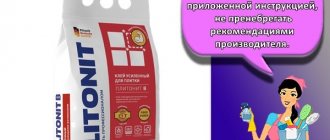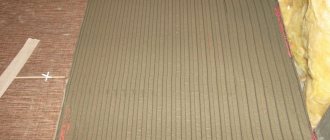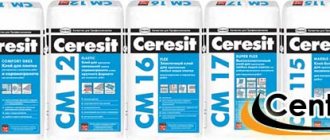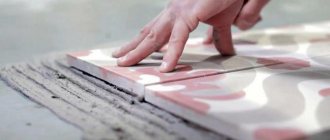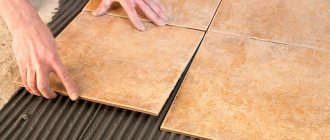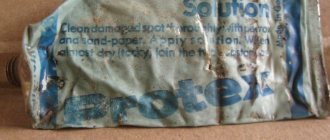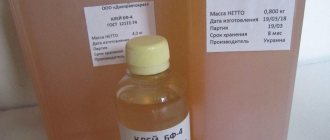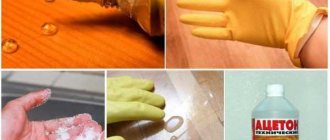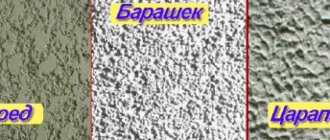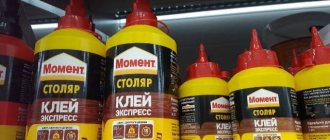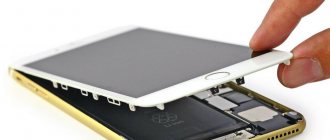Specifications
Plitonit tile adhesive is used for laying ceramic, porcelain stoneware, clinker slabs on horizontal and vertical planes with any base.
Technical characteristics of Plitonit:
- Plitonite is produced in three series: a, b, c. Packaging is carried out in bags of 5 and 25 kg.
- The contents of the bags are a dry, gray powdery mixture. To prepare the solution, you need to dilute the powder with water according to the instructions.
- The mixture contains cement, binders, adhesive components, modifiers, and fillers.
- Powder grains no more than 0.63 mm.
- The finished solution is plastic, which makes it possible to hold the tiles on a vertical area without slipping.
- It is permissible to form a glue joint up to 10 mm.
- Commissioning of the tile cover is permissible no earlier than one day later.
- Temperature conditions when applying the layer are 5–30 degrees, during operation – +60 degrees.
- Adjustment of the tile layer is permissible within 15 minutes; the finished solution requires consumption within 4 hours. After the expiration date, the mass will lose its properties and will not provide the required adhesion.
- Service life 12 months.
View this publication on Instagram
Publication from SKS Construction Trading House (@std_sks_spb) July 23, 2022 at 5:34 PDT
Adhesive for ceramic tiles and porcelain and clinker floor tiles
Designed for gluing:
- all types and sizes of wall and floor ceramic tiles indoors and outdoors;
- indoor porcelain stoneware and clinker tiles. On surfaces made of concrete, reinforced concrete, cellular concrete, brick, cement, lime-cement and gypsum plasters, as well as plasterboard, tongue-and-groove and gypsum boards.
The glue is easy to use, easily mixed with water, has high plasticity, and the tiles do not slide off vertical bases during the work process.
The mixture can be used for tiling heated floors and indoor swimming pools with a volume of no more than 50 m³. The temperature of the adhesive joint during operation is +60°C. The maximum thickness of the adhesive seam is 10 mm. The maximum filler fraction is 0.63 mm.
| Material consumption | |||||
| Length of the longest side of the tile, mm | up to 108 | 109-200 | 201-250 | 251-300 | from 300 |
| Spatula tooth height, mm | 4 | 6 | 8 | 10 | 12 |
| Consumption of dry mixture per 1m³, kg | 1.7 | 2.6 | 3.4 | 4.3 | 5.1 |
The material consumption is indicated when working on a leveled surface, without taking into account losses and may vary depending on the method of application, the unevenness of the base and the professional skills of the work performer.
Advantages and disadvantages
Among the advantages of using plitonite adhesive mass, the following are highlighted:
- The solution does not require special preparation; the dry mixture mixes well in water without forming lumps.
- Increased adhesion.
- Low level of slip coefficient from the vertical plane.
- The flexibility of the layer allows you to hold the tiles, preventing cracking when the building shrinks.
- Moisture and frost resistance allows work to be carried out from the street side.
- Availability.
Negative points include:
- The base must be carefully prepared before laying, otherwise the tile layer will move away from the surface.
- The minimum packaging is 5 kg, so you will have to overpay for an unnecessary amount of glue.
Release forms
The stores offer a huge range of products. The user has the opportunity to select the desired material depending on the requirements, properties of the tile and the base. The most popular adhesives:
- "Plitonite A". Typically, this product is used as a universal masonry mortar. Suitable for different types of tiles, does not slip on vertical surfaces, and is well fixed on horizontal bases. "Plitonit A" has excellent moisture resistance.
- "Plitonite B" The material includes additional additives that increase its frost resistance. Suitable for ceramic tiles and porcelain stoneware.
- "Plitonite B+". The water resistance of this composition is increased, so it can be used for finishing work in wet rooms, swimming pools, saunas. Due to its frost resistance, the mixture is used for various facade works.
- "Plitonit Express Wb". This glue has all the properties of “Plitonit B”, but has a higher drying speed (quick-hardening composition). After just two hours, you can grout the joints, so the glue will come in handy during emergency work.
- "Plitonite B Maxislayer." Used for finishing surfaces of large-format slabs and stone blocks, providing a high degree of adhesion. The product can be applied in a layer of up to 30 mm.
- "Plitonite B Clinker". A specialized composition for laying clinker and stone, does not shrink, and is highly reliable.
- "Plitonit V Pro". Professional composition for complex work, suitable for mosaics, finishing plinths and facades, terraces, balconies.
- "Plitonite V Superpol". Used for floor cladding, made on a cement base. Helps fill small and medium voids and level the floor.
- "Plitonit Superfireplace Thermal glue." Suitable for cladding different types of tiles on stoves, fireplaces, and other bases that will subsequently be subject to heating. This glue can also be used to grout heated surfaces. Operating temperature – up to +150 degrees.
- "Plitonit S". The composition is used on problematic substrates - on old ceramics, paint, surfaces with residues of other adhesives. The product is also suitable for gluing tiles outside buildings and in swimming pools.
- "Plitonite S Marble". Specialized adhesive for marble finishing, has high moisture resistance, hardens quickly (in 8 hours), suitable for swimming pools.
Preparation of mortar mixture
The condition for preparing the solution is room temperature of the driest mixture of plytonite and water. If the bag was stored or purchased in cool weather, then before use it should be kept warm for up to two hours.
The solution is made from purified water without chemical compounds, which is poured into a container with a cleaned bottom and walls. It is forbidden to knead in a dirty container or with dirty tools. If a construction mixer is used, then the attachment is new or cleaned from the previous batch.
According to the instructions, for one kilogram of dry Plitonit glue you need 240 ml of water. That is, approximately 6 liters of water are consumed for a 25 kg bag.
Initially, water is poured, and then the dry mixture is poured.
To check whether the solution has been prepared correctly, apply it to the wall; if there is no dripping, then the consistency is correct. The stirred mixture is left for 5 minutes to swell, then mixed again. Throughout the work, the mixture must undergo additional mixing.
Useful video on the topic:
Advantages and disadvantages
Using Plitonit adhesives for work has a large number of advantages. The powder is easy to dilute with water, the mass is obtained almost immediately without lumps, but like thick sour cream. The advantages also include:
- Excellent bonding. The composition of the glue is such that the mixture for work is very reliable and strong, which holds the tiles perfectly. If the tiles are large, you can buy specialized adhesive of this brand specifically for such voluminous materials.
- High degree of elasticity. This is very important for a material that is subject to stress (for example, when a house shrinks). Since ceramic tiles are a fairly fragile material, this adhesive compensates for this with its elasticity; the tiles do not break or crack. This adhesive is great for laying tiles on the floor.
- High level of resistance of Plitonite to moisture. All types of this glue are quite moisture resistant, but some of them have this parameter very high. This glue is used for pools, facades, and so on.
- High level of frost resistance. There are special Plitonite adhesives that can also be used for external work. Such a seam does not crack or crumble even after several cycles of defrosting and freezing.
- High level of wear resistance of Plitonite. This product will last a long time, just like the material that is glued to it. The C series adhesives are especially strong.
Among the positive qualities of Plitonite, the following are also noted:
- Easy to knead;
- Easy to apply;
- Dries quickly;
- Short installation time;
- Low price;
- Versatility.
Among the negative aspects of Plyton, only one thing can be said - this is that it is necessary to prepare the surface very carefully and efficiently, otherwise the tile may not stick well.
In addition, the minimum packaging of glue is a 5 kg bag, so if you need to glue the tiles, there will be extra costs.
Work order
The work is carried out under the conditions prescribed by the manufacturer (at a temperature of 5–30 degrees), then the layer will dry evenly, ensuring complete adhesion. Put the tiled surface into operation no earlier than one day after installation. This also applies to grouting work.
The tile material is completely cleaned from the working side. The coating that is covered with tiles should not contain unevenness, old material, deformation is excluded.
The surface is puttied to remove cracks and crevices, then primed. It is advisable to buy the primer of the same brand as the adhesive mixture. If the room is damp, then the primer should contain antiseptics and antifungal components.
Tile adhesive Plitonit V Reinforced with reinforcing fibers class C1 T 25 kg
Adhesive Plitonit B Reinforced for tiles in wet rooms 25 kg – a dry construction mixture intended for tiling floors and walls for interior and exterior work. Class C1 T, GOST R 56387-2015
Used for installation of wall and floor tiles of all types and sizes indoors and outdoors, for all types of clinker tiles indoors and for floor porcelain tiles up to 60x60 cm in size. Used on bases made of concrete, reinforced concrete, cellular concrete, brick, cement, lime-cement and gypsum plasters, on plasterboard sheets, tongue-and-groove slabs. PLITONIT V glue is also used for lining indoor swimming pools (volume no more than 50 m3) and heated floors.
Advantages
- Versatility - can be used for a variety of reasons
- Laying tiles of various types and sizes is allowed
- Possibility of use for interior and exterior work
- Water and frost resistance
- Possibility of use in swimming pools and underfloor heating systems
INSTRUCTIONS FOR USE
Preparation of the base The base must be strong, not subject to shrinkage and deformation, free from dirt, oils, fats, all types of paints and adhesives, and peeling elements. Treat gypsum bases and surfaces with high water absorption with a primer. Carry out further work after the primer has completely dried.
Mixing the mixture Use clean water at room temperature. Pour the mixture into a prepared container with water in the proportion: 0.19-0.24 liters of water per 1 kg of dry mixture. Mix for 2-3 minutes using an electric mixer or an electric drill with an attachment, maintaining a rotation speed of no more than 600 rpm - until a homogeneous consistency is obtained. After obtaining the required consistency, maintain a technological pause for 5 minutes, then repeat mixing. The finished mixture can be used within a period of no more than 4 hours.
Applying the mixture and installing tiles Apply the finished mortar mixture to the base using a smooth trowel, then give the layer a comb structure with a notched trowel. Apply the mixture to an area that can be tiled within 15 minutes. Place the tile on the adhesive mortar surface and press it in with small turning movements - the position of the tile can be adjusted within 20 minutes after installation. If a dried crust forms on the surface of the applied glue, it is necessary to remove the solution and apply a new layer. Lay tiles with open joints, leveling them with appropriate devices - crosses.
Application of glue using a combined method Application in this way is carried out when cladding pools, facades, terraces, balconies, heated floors, tiles with a back side relief height of more than 2 mm and with a size of more than 30x30 cm - to avoid voids under the tiles and to improve adhesion. Apply to the base in the standard manner (as described above). Apply adhesive to the back of the tile with a notched trowel, then smooth it evenly over the entire area of the tile with a smooth trowel. When installing the inlet using a combined method, the mixture consumption increases by 1.3 kg/m2, with a layer thickness of 1 mm
Rules and recommendations
- When carrying out work and over the next 3 days, the temperature of the air, base and tiles should be in the range from +5? C to +30? C
- The temperature of the mortar mixture during the work should be from +10? C to +30? C
- Walking on the tiled floor and grouting joints is allowed no earlier than after 24 hours
- Turning on heated floors is possible no earlier than 7 days after laying the tiles
- During the work process, the mortar mixture should be stirred periodically
- It is prohibited to introduce additional water into the finished mortar mixture.
There are 48 pieces on a pallet.
Subtleties of application
When working, there are subtleties that should be taken into account:
- The adhesive is spread on the tiles using a notched trowel.
- You should not apply the adhesive mixture directly to a large surface area, as the formation of a dry film will reduce the quality of adhesion.
- The same distance must be maintained between the tiles (crosses must be placed); adjustments to the location are carried out within 20 minutes.
- Excess should be removed immediately after adjustment to avoid later scraping from the face of the tile.
- When laying large tiles or on a “warm floor” system, the application is combined, the solution is applied to the tile and the main surface.
- Use is prohibited within 24 hours after installation.
- The work is carried out subject to the availability of IZ funds.
- If the solution gets on exposed skin or mucous membranes, rinse with running water.
Interesting video on the topic:
How to calculate consumption
The declared consumption rates are 1.7-5 kilograms of mixture per square meter. The amount of glue depends on a number of factors:
- thickness, material and size of tiles;
- base processing quality;
- skills of the master.
See also
Description and technical characteristics of Uranium glue, rules of use
To stick a small tile (10x10 centimeters) with a narrow seam, it takes 1.7 kilograms per square meter. If the size is 30x30 centimeters, the seam is 2-3 millimeters, you will need 5 kilograms. To calculate consumption, this indicator is multiplied by the area of the surface to be pasted.
Can tile adhesive be used outdoors?
Improved glue
allows you to work with large-format slabs, the size of which is more than 300x300 mm.
This factor, of course, must be taken into account when laying it outdoors -
if the project involves
the use
of large, heavy tiles, you should not limit yourself to frost-resistant qualities alone.
Interesting materials:
How to properly lay floor slabs on walls? How to properly place a backing with foil under the laminate? How to lay corrugated sheets correctly? How to lay brick pillars correctly? How to properly glue paper wallpaper to walls? How to properly glue PVC edges? How to glue wallpaper correctly, from what angle to start? How to properly glue wallpaper behind a radiator? How to properly glue slabs to the ceiling? How to glue fiberglass correctly?
Cost and positive characteristics
The price of a package of “Plitonit” series B is 160-200 rubles/25 kg, the cost of series C adhesives is higher - up to 300-320 for a similar pack. You can purchase the material at any hardware store. Experts note the moderate price of the glue with many advantages - impeccable strength, high reliability, ease of use. “Plitonit” is perfectly compatible with any base and type of tile, it is universal, and safe in composition, which makes it one of the most popular products on the market.
Source
What happens if you mix tile adhesive?
Can tile adhesive be mixed
with cement when laying tiles
If
you lay tiles on such a solution, then this may deteriorate not only moisture resistance, but also adhesiveness, as a result of which the tile will not attach as securely as we would like.
Interesting materials:
How do Lupins grow? How to cut a bottle without a glass cutter? How to dilute Aktara from whiteflies? How to propagate barberry from cuttings? How to propagate Begonia Everblooming? How to breed begonia? How to dilute gasoline for a chainsaw? How to dilute gasoline for a scythe? How to dilute gasoline for a Husqvarna trimmer? How to dilute gasoline with oil for a Husqvarna chainsaw?
